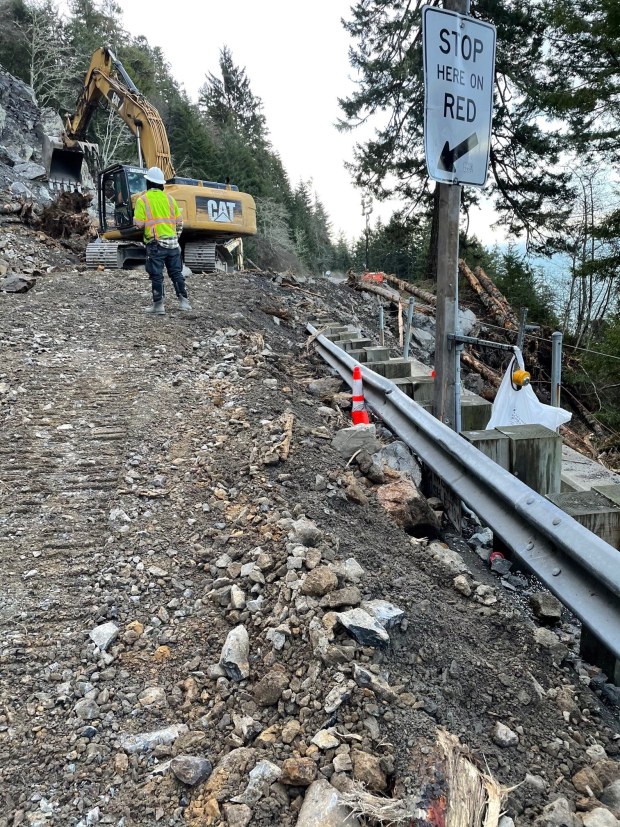Caltrans Unveils Final Plans for Last Chance Grade Detour
Last Friday, the office of California Senate President Pro Tempore Mike McGuire (D-North Coast) announced “a $40 million investment approved by the California Transportation Commission today to jump-start the design phase of the long-awaited Last Chance Grade Project.”
The investment will move forward a plan selected by Caltrans in early June (previously called “Alternative F”) for “a 6,000-foot tunnel that bypasses area landslides and realigns the highway.” In a press release issued on June 13, the agency called the plan “essential to advancing the Last Chance Grade Project efficiently.”
“Four words sum it up: It’s about damn time,” McGuire said in his office’s press release. “This $40 million is a turning point for the project and will formally kick off the design phase of the … tunnel through Last Chance Grade, finally delivering the secure route on Highway 101 that the North Coast deserves.”
Caltrans spokesperson Myles Cochrane told the Times-Standard that the $40 million investment represented a “partial contribution toward the total funds needed” to design the project. “It enables roughly the first year of pre-construction work, including design, environmental support and geotechnical investigations,” Cochrane said. “An estimated $185 million in additional funds will be needed to fully fund the rest of the design phase.”
Additionally, Cochrane said, Caltrans is currently working with two stakeholders to secure the land — a process that could expedite the agency’s timeline.
“Caltrans is coordinating with two landowners, California State Parks and the National Park Service, to transfer land needed for the project,” he said. “These right-of-way acquisition efforts are occurring alongside design and environmental permitting efforts and are expected to be completed by December 2030. To start construction at that time, Caltrans will need a complete set of plans, estimates and specifications supported by engineering studies and fieldwork, all environmental permits secured, and all required right-of-way acquired. Early completion of any of these efforts could help reduce project risk and cost.”
In early June, McGuire called the selection of Alternative F “an incredible milestone for Caltrans District 1 (that) represents six years of intensive collaboration and analysis.” When completed, Caltrans estimates that the project will cost approximately $2.1B in 2031 dollars. The project is currently slated to begin construction in 2030, and completion of the project is scheduled for 2038, with Caltrans saying that it is “looking for any and all opportunities to accelerate this timeline.”

Cochrane said that Caltrans is currently working on “a coordinated approach to fund the remaining construction and right-of-way capital costs … working with the California Transportation Commission (CTC), Federal Highway Administration (FHWA), and legislative advocates to pursue programmatic funds, discretionary grants, financing options, and any other potential sources of significant funding.”
This month’s announcements follow the completion of a Draft Environmental Impact Report this February. McGuire’s office noted that $50 million had already been invested in securing the environmental review of the project.
Last Chance Grade, a three-mile stretch of Highway 101 roughly 10 miles South of Crescent City along the shoreline in Del Norte Coast Redwood State Park and Redwood National Park, has had problems for decades. In 1972, a couple driving back from dropping their son off at then-Humboldt State University was killed by a landslide along the stretch of road. The unstable coastline has experienced hundreds of slides in recent years, frequently disabling the highway and causing protracted delays.
Alternative F was chosen in lieu of “Alternative X,” which would have involved “re-engineering the existing route in the hopes it would be resilient among the area’s mapped landslides.” The 6,000-foot tunnel (just over a mile long) will be the longest ever constructed by Caltrans. (For context, the famous Lincoln Tunnel connecting New Jersey to Manhattan is 1.5 miles long.)
Stakeholders in the project, Cochrane said, include the aforementioned California State Parks and the National Park Service; tribal governments including the Tolowa Dee-ni’ Nation, Tolowa Nation, Elk Valley Rancheria, Yurok Tribe and Pulikla Tribe of Yurok People; regulatory agencies including the California Coastal Commission, California Department of Fish and Wildlife, U.S. Fish and Wildlife Service, U.S. Army Corps of Engineers and U.S. Environmental Protection Agency; and nonprofit partners like EPIC, Save the Redwoods League and Friends of Del Norte.
They also include local partners like Del Norte County and the Del Norte Local Transportation Commission, business partners and business advocates, and Pacific Power and local emergency response agencies.
Readers can learn more about the project on its website, https://lastchancegrade.com .
Robert Schaulis can be reached at 707-441-0585.
Post a Comment for "Caltrans Unveils Final Plans for Last Chance Grade Detour"
Post a Comment